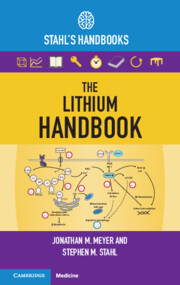Book contents
- The Lithium Handbook
- Reviews
- The Lithium Handbook
- Copyright page
- Contents
- Foreword
- Preface: How to Use This Handbook
- Introduction
- 1 The Efficacy Story
- 2 Renal Handling of Lithium
- 3 Clinical Pharmacokinetics
- 4 Lithium Initiation and Monitoring
- 5 Management of Routine Lithium Related Adverse Effects
- 6 Lithium Toxicity
- 7 Special Populations and Circumstances
- 8 Lithium Discontinuation
- Index
- References
2 - Renal Handling of Lithium
Proximal and Distal Handling of Lithium; The Staging of Chronic Kidney Disease; Lithium Related Effects on Renal Function
Published online by Cambridge University Press: 09 February 2024
- The Lithium Handbook
- Reviews
- The Lithium Handbook
- Copyright page
- Contents
- Foreword
- Preface: How to Use This Handbook
- Introduction
- 1 The Efficacy Story
- 2 Renal Handling of Lithium
- 3 Clinical Pharmacokinetics
- 4 Lithium Initiation and Monitoring
- 5 Management of Routine Lithium Related Adverse Effects
- 6 Lithium Toxicity
- 7 Special Populations and Circumstances
- 8 Lithium Discontinuation
- Index
- References
Summary
In a 1989 review entitled “Long-term treatment with lithium and renal function: A review and reappraisal,” the pioneering Danish psychopharmacologist Mogens Schou concluded: “The fear of eventual kidney insufficiency as a result of long-term lithium treatment can be set at rest” [1]. Despite the certainty advanced by the preeminent authority on lithium at that time – the man responsible for all of the early data on lithium’s efficacy and the first double-blind placebo-controlled trials – fear of lithium’s long-term renal adverse effects remains a significant concern to clinicians, a concern that is often disproportionate to the emerging data in this area.
- Type
- Chapter
- Information
- The Lithium HandbookStahl's Handbooks, pp. 95 - 150Publisher: Cambridge University PressPrint publication year: 2023



